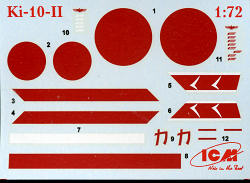
ICM 1/72 Ki-10-II
| KIT #: | 72311 |
| PRICE: | $13.55 from GreatModels |
| DECALS: | Two Options |
| REVIEWER: | Scott Van Aken |
| NOTES: | Might want to treat this like a short run. |

| HISTORY |
The Ki-10 was designed by Japanese aeronautical engineer Takeo Doi, who had succeeded Richart Vogt as chief designer for Kawasaki. The design was in response to a requirement issued by the Imperial Japanese Army for a new fighter, and was the winner of a competition against Nakajima's Ki-11. Although the low-wing monoplane offered by Nakajima was more advanced, the Army preferred the more maneuverable biplane offered by Kawasaki.
The Kawasaki design had unequal-span wings, braced by struts, and with upper-wing ailerons. The structure was of all-metal construction, which was then fabric-covered. Armament consisted of two 7.7 mm (.303 in) Type 89 machine guns, synchronized to fire through the propeller. The initial production version was powered by a liquid-cooled 633 kW (850 hp) Kawasaki Ha-9-IIa V engine.
The Ki-10 was deployed in Manchuria and in the initial campaigns of the Second Sino-Japanese War in northern China. It proved an excellent dogfighter against the Chinese air force, including at the Battle of Wuhan. However, by the time of the Nomonhan Incident in 1939, against the forces of Soviet Russia, it was largely obsolete.
At the beginning of the Pacific War, the Ki-10 was retired to training and secondary missions, but later returned to front-line service, performing short-range patrol and reconnaissance missions in Japan proper and China in January-February, 1942.
| THE KIT |
ICM's kit of the Ki-10 is only the second injection molded kit of this plane of which I am aware. The other was a 1/48 version by Fine Molds (who may have also done it in 1/72). The ICM kit is nicely molded in light grey plastic. There is a single sprue that is a bit on the flimsy side. Thanks to the sprue gates impinging on the plastic parts, some small chunks were taken out of the trailing edges of the upper wing as the sprue attachment point broke away by the flexing of the overall sprue. There is also a bit of flash on the N struts.
The kit itself is very simple as these things go. Interior is a floor, rudder pedals, stick and seat back. There is some framing detail on the interior side wall. ICM has chosen to use a piece of acetate for the windscreen. This must be cut out, folded and a hole drilled in it for the gun sight tube. Attachments for the various struts consist of small indentations on the wings and fuselage. This should be adequate, though some may want to drill them out a bit more.
 Instructions are very well done with five major construction steps. Each drawing provides color information where it is required using Model Master paints. The fifth construction step is rigging. Using this diagram in conjunction with the box art should be most helpful. I should mention that the small sleeves shown at the ends of each rigging line are not provided in the kit, nor is the wing spreader bar. I tried to make one of these bars on a 1/48 kit and it was disaster. I can imagine the work needed in 1/72! Markings are for two planes, both in JAAF green-grey (which must be mixed). One is the plane of Tateo Kato of the 64th Sentai as shown on the box art. The other is from the 77th Sentai, both from the 1938 time period. Decals are well done and provide all you need.
Instructions are very well done with five major construction steps. Each drawing provides color information where it is required using Model Master paints. The fifth construction step is rigging. Using this diagram in conjunction with the box art should be most helpful. I should mention that the small sleeves shown at the ends of each rigging line are not provided in the kit, nor is the wing spreader bar. I tried to make one of these bars on a 1/48 kit and it was disaster. I can imagine the work needed in 1/72! Markings are for two planes, both in JAAF green-grey (which must be mixed). One is the plane of Tateo Kato of the 64th Sentai as shown on the box art. The other is from the 77th Sentai, both from the 1938 time period. Decals are well done and provide all you need.
| CONCLUSIONS |
For those working in 1/72 whose penchant is inter-war aircraft, this is a must have to add to the collection.
| REFERENCES |
http://en.wikipedia.org/wiki/Ki-10
You can find this and other interesting kits and accessories atGreatModels If you would like your product reviewed fairly and fairly quickly , please contactme or see other details in the